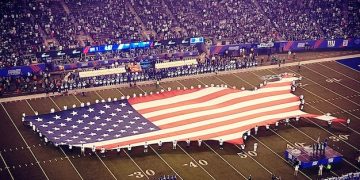NFL Expansion to 34 Teams by 2027: Latest Rumors & Prospects

The prospect of the NFL expanding to 34 teams by 2027 is a topic of significant speculation, driven by league commissioner Roger Goodell’s statements hinting at future expansion and the substantial economic opportunities new markets present.
The National Football League, a titan of American sports, consistently captures the nation’s attention, and few topics ignite fan speculation quite like expansion. Will the NFL expand to 34 teams by 2027? This question echoes through sports media, fan forums, and boardrooms, fueled by persistent whispers and the league’s history of strategic growth.
The NFL’s Historical Growth Trajectory
The NFL has a storied history of evolution and expansion, adapting to changing landscapes and seizing new opportunities. From its humble beginnings as the American Professional Football Association to its current status as a 32-team powerhouse, growth has been a constant.
Understanding this historical context is crucial when evaluating the likelihood of further expansion. The league has consistently sought to maximize its reach and revenue, adding teams in strategic markets as business acumen and fan interest dictated.
Early Beginnings and Mergers
The foundational years of the NFL were marked by a gradual aggregation of regional teams, culminating in the formal establishment of the APFA in 1920. Key mergers, particularly the integration of the American Football League (AFL) in 1966, dramatically reshaped the league’s structure and competitive landscape. This period of consolidation laid the groundwork for the modern NFL.
- The 1920s saw the league establish its initial footprint with various regional teams.
- The post-WWII era brought increased professionalization and stability.
- The merger with the AFL created a unified, dominant football league.
- This era set precedents for future expansion based on market viability and talent pool.
Modern Expansion Trends
In more recent decades, the NFL has expanded cautiously but deliberately. The addition of the Carolina Panthers and Jacksonville Jaguars in the mid-1990s, followed by the Houston Texans in 2002, showcased a pattern of targeting underserved or growing metropolitan areas. These expansions were often driven by a combination of strong local economies, passionate fan bases, and a lack of existing major professional sports teams in some cases.
The criteria for expansion have become increasingly stringent. Prospective ownership groups must demonstrate significant financial stability, a commitment to building state-of-the-art facilities, and a deep understanding of the local market’s potential. The league aims for long-term sustainability, not merely short-term gains, making each expansion an intricate undertaking.
Ultimately, the NFL’s journey of growth underscores its adaptability and foresight. Each expansion phase has reinforced its position as a cultural and economic juggernaut. This history provides a lens through which to assess future possibilities, including the prospect of reaching 34 teams by 2027.
Commissioner Goodell’s Stance and Economic Drivers
Roger Goodell, the long-serving NFL Commissioner, has often been both a proponent and a cautious architect of the league’s future. His public statements on expansion are closely scrutinized, offering insights into the league’s long-term vision. Goodell has, on multiple occasions, hinted at the potential for future expansion, acknowledging the league’s robust health and the growing demand for franchises.
The economic considerations are paramount. New teams represent new revenue streams through media rights, sponsorship deals, ticket sales, and merchandise. For a league that generated over $18 billion in revenue in a recent season, adding two more franchises could significantly boost those figures. This financial incentive is, arguably, the strongest driving force behind any expansion talks.
Goodell’s Expansion Remarks
While Goodell has not committed to a specific timeline or number of teams, his remarks often suggest that expansion is “on the horizon.” He typically emphasizes the importance of market stability and the right ownership groups being in place before such a move. His statements reflect a strategic approach to growth, ensuring that any new additions enhance rather than dilute the league’s product.
The commissioner’s measured optimism tends to fuel enthusiasm among prospective cities and ownership groups, who view these hints as official acknowledgment of expansion possibilities. His words are carefully chosen, often balancing the desire for growth with the need for competitive balance and the protection of existing franchises’ interests.
Revenue Streams from New Franchises
The financial benefits of expansion are multi-faceted. When a new team joins the league, it contributes to shared revenue pools, increasing the overall pie for all owners. This includes:
- Increased Media Rights: More games mean more content for broadcast partners, potentially leading to even larger media deals.
- Expanded Sponsorship Opportunities: New markets open doors for localized and national sponsorships, tapping into previously unreached demographics.
- Enhanced Merchandise Sales: Fresh team brands drive new apparel and merchandise sales, generating significant income.
- Boosted Ticket and Concession Revenue: A new stadium promises sell-out crowds and robust in-venue revenue for at least the initial years.
These economic drivers make expansion an attractive proposition for the league’s owners, even as they consider the logistical challenges of integration. The prospect of tapping into new fan bases and generating billions in additional revenue makes a compelling case for growth. Goodell’s cautious yet positive outlook aligns with this underlying economic reality, making the 2027 timeline plausible if the market dynamics align.
Potential Expansion Cities and Market Viability
Speculation about which cities might host new NFL franchises is a constant source of discussion among fans and analysts. Several metropolitan areas consistently emerge as strong contenders, each presenting unique advantages and challenges. The NFL will carefully assess market viability, which extends beyond just population size to include economic strength, corporate support, existing sports infrastructure, and a demonstrable local passion for football.
The league has a history of prioritizing markets that can sustain a franchise long-term, not just for an initial honeymoon period. This means evaluating everything from corporate relocation trends to regional income levels and the potential for a new stadium deal. The right city is one that guarantees significant return on investment for the league and its owners.
Top Contender Cities
While no official shortlist exists, several cities are frequently mentioned in expansion discussions:
- London, UK: The NFL has invested heavily in the UK market with the International Series. A permanent team in London would be a monumental step towards globalizing the league, though logistical challenges remain significant.
- Toronto, Canada: A major North American city with a strong sports fan base and economic ties to the US. It offers proximity and an established appreciation for American football, having hosted previous NFL games.
- St. Louis, MO: With a pre-existing modern stadium (though not an NFL-caliber one currently) and a history of supporting the Rams, St. Louis seeks redemption for its lost franchise.
- San Antonio, TX: A rapidly growing metropolitan area in a football-mad state, offering a strong demographic profile and corporate base, though it would be challenging to differentiate itself from Houston and Dallas.
- Orlando, FL: Another growing market in a state that loves football, and a major tourism hub. It possesses significant potential for fan engagement and corporate partnerships.

Each of these cities presents a compelling, albeit complex, case for expansion. The NFL’s ultimate decision will weigh economic benefit against logistical realities.
Criteria for Selection
The NFL’s criteria for selecting an expansion city are rigorous and multi-faceted, reflecting the significant investment involved. Key factors include:
- Fan Base Enthusiasm: A proven track record of strong fan engagement for other sports or special NFL events. This includes season ticket potential and broader community support.
- Corporate Support: The presence of major corporations willing to invest in sponsorships, luxury suites, and other business-to-business opportunities. A strong corporate tax base is vital for economic stability.
- Infrastructure and Facilities: The ability to construct a state-of-the-art, revenue-generating stadium, or adapt an existing one, that meets NFL standards. This involves complex negotiations and significant public-private partnerships.
- Broadcast Market Size: The potential reach for local television viewership, which directly impacts media rights valuations. Larger markets generally provide more immediate broadcast value.
- Geographic Location: Strategic placement within the league’s existing footprint, considering travel impact and divisional alignment. Proximity to existing teams can be both an advantage and a challenge.
These criteria collectively form a robust framework for evaluating potential expansion candidates. The NFL isn’t just looking for a city that wants a team; it’s looking for a powerful partner that can contribute meaningfully to the league’s long-term financial and cultural success. The 2027 timeline depends heavily on finding two such ideal fits.
Challenges and Obstacles to Expansion
While the prospect of NFL expansion is exciting, it is far from a simple endeavor. Numerous challenges and obstacles must be navigated, from unanimous owner approval to the complex logistics of competitive balance and player pool dilution. Each of these factors weighs heavily on the timeline and feasibility of adding two new teams by 2027.
The NFL operates as a collective of 32 immensely profitable businesses, and any decision of this magnitude requires careful consensus building. Owners will scrutinize potential impacts on their own franchises, considering everything from shared revenue adjustments to schedule implications. This intricate negotiation process can often be lengthier and more complex than outsiders might imagine.
Unanimous Owner Approval
A significant hurdle for any NFL expansion is the requirement for a supermajority, typically three-quarters, of the existing owners to approve the addition of new franchises. This means that at least 24 of the 32 owners must vote in favor. Achieving such widespread agreement can be challenging, as individual owners may have concerns about:
- Dilution of Revenue: New teams mean the existing revenue pie is split among more franchises, potentially reducing individual team earnings, at least initially.
- Competitive Balance: Concerns that adding new teams might dilute the talent pool, leading to less competitive play across the league.
- Relocation Disputes: Established owners might fear that new markets could draw away existing fans or future opportunities for their own franchises.
These concerns require extensive negotiation, financial modeling, and often, significant compensation packages for existing teams to mitigate perceived losses. The process is never a rubber stamp, and vocal opposition from a few key owners could derail the entire plan.
Logistical and Competitive Concerns
Beyond financial and approval matters, the logistical and competitive aspects of expansion present considerable headaches:
- Player Pool Dilution: Adding 100+ new roster spots (assuming two 53-man rosters plus practice squads) draws from the existing talent base, potentially thinning out the quality of play, especially in the short term.
- Scheduling Complications: An uneven number of teams (if only one were added initially) or the integration of two new teams into existing divisional and conference structures requires a complete overhaul of the scheduling matrix.
- Draft Pool Impact: The new teams would historically receive preferential draft picks for an initial period, impacting the draft strategies of established teams.
- Stadium Infrastructure: The requirement for state-of-the-art stadiums in new cities can lead to prolonged negotiations with local governments and significant financial outlays.
These are not insurmountable barriers, but each requires meticulous planning and potentially years of preparation. The NFL is known for its methodical approach, and rushing such complex changes could lead to unforeseen negative consequences. The 2027 deadline imposes a strict timeline on addressing these multifaceted challenges effectively, making it an ambitious yet not impossible target.
Impact on League Structure and Schedule
The addition of two new teams to the NFL would necessitate a significant restructuring of the league, impacting everything from conference alignment to the regular season schedule and playoff format. The current 32-team setup is perfectly symmetrical, with four divisions of four teams in each of the two conferences (AFC and NFC). Expanding to 34 teams breaks this symmetry and demands a thoughtful reimagining of the league’s competitive framework.
Maintaining competitive balance while introducing new franchises is crucial. The NFL prides itself on its parity, where any team can contend for a Super Bowl given the right circumstances. Any structural changes would need to preserve this core tenet, avoiding the creation of perpetually strong or weak divisions due to new team placement.
Potential Restructuring Scenarios
Several scenarios could emerge if the NFL expands to 34 teams:
- Option 1: Two Conferences, Uneven Divisions: Unlikely. This would create significant scheduling imbalances and competitive disadvantages.
- Option 2: Three Conferences (AFC, NFC, and New): Highly improbable as it would fundamentally alter the historical foundation of the league.
- Option 3: Re-alignment to Eight Divisions of Four and Two Divisions of Five: This could maintain 32 teams in four-team divisions, then create two new divisions of five teams from existing and new franchises. This would require substantial re-alignment.
- Option 4: Four Conferences of Two Divisions (each with 4-5 teams): This is also a radical shift that’s unlikely to be adopted.
- Option 5: Expansion to 36 Teams for Full Symmetry: A long-term possibility, but not by 2027. If the league is to expand to 34, it would be an interim step.
The most probable scenario for 34 teams is a temporary re-alignment, potentially leading to an eventual expansion to 36 teams to regain full symmetry. This would involve minor, yet impactful, shifts for existing teams.
Scheduling and Playoff Implications
A shift to 34 teams would immediately impact the regular season schedule, potentially leading to:
- Adjusted Divisional Play: If divisions remain at four teams, some teams will have to shift. If divisions become uneven, scheduling within those divisions will become more complex.
- Expanded Schedule?: While unlikely, the possibility of extending the regular season beyond 17 games (e.g., to 18 games) could be revisited to accommodate more inter-conference play or more games overall, though player safety concerns remain paramount.
- Playoff Format Modifications: With more teams, the current 14-team playoff format might need adjustment. This could mean more wild card spots, or a re-evaluation of byes, to allow for fair representation and competitive access for the new teams.
Any changes to the schedule and playoff format are tightly intertwined with the collective bargaining agreement with the NFL Players Association. These are massive undertakings that require extensive modeling and negotiation to ensure fair play and continue to deliver the compelling product fans expect. The 2027 timeline presents a significant challenge for integrating two new teams seamlessly into an already complex and highly optimized system.
Historical Precedent and Industry Trends
Examining historical precedents in sports expansion and broader industry trends offers valuable context to the NFL’s potential move to 34 teams. Major professional sports leagues in North America have a long history of phased growth, often driven by opportunities that align with their business models. The NFL’s current exploration of expansion is not an isolated event but rather part of a larger pattern seen across the sports landscape.
The modern era of sports business is characterized by exponential growth in media rights, global reach, and diversified revenue streams. Leagues are constantly seeking new ways to tap into these trends, and expansion into vibrant, underserved markets is a proven strategy. This includes both domestic and international ventures, reflecting a broader shift towards global sports consumption.
Expansion in Other Major Leagues
Other major North American sports leagues have recently undergone significant expansion:
- NHL: Expanded to 32 teams with the addition of the Vegas Golden Knights (2017) and Seattle Kraken (2021). These expansions were highly successful, demonstrating strong market demand.
- NBA: Though not recent, the NBA has a history of strategic expansion, notably with the Charlotte Hornets and Toronto Raptors in the 1990s. There are ongoing discussions for future expansion to potentially Las Vegas and Seattle.
- MLB: While the last expansion was in 1998, MLB consistently evaluates new markets. It has seen immense success from its current 30-team structure.
- MLS: Continues a rapid expansion pace, demonstrating the viability of new professional sports teams in diverse U.S. and Canadian markets, albeit at a different scale than established leagues like the NFL.
These examples show that planned, strategic expansion can be highly profitable and enhance the league’s overall appeal. The success of the NHL’s recent additions, in particular, offers encouragement for the NFL’s aspirations, proving that new franchises can immediately become competitive and financially viable.
Global Sports Market Trends
The NFL is also observing broader global sports market trends, which increasingly point towards internationalization. The league’s own International Series games in London, Mexico City, and now Germany are clear indicators of this strategy. A permanent London franchise would be a transformative step, leveraging the league’s brand recognition beyond North America.
Factors influencing these global trends include:
- Technological Advances: Digital media and streaming platforms make it easier for leagues to reach international audiences, fostering demand for in-person events.
- Growing Sports Tourism: Fans are willing to travel across borders to witness marquee sporting events, boosting local economies.
- Increased Investment in Sports: Global capital is increasingly flowing into sports franchises and infrastructure, facilitating large-scale projects like new stadiums.
- Cultural Exchange: Sports act as a powerful vehicle for cultural exchange, generating new fan bases and deepening existing relationships.
These macro trends provide a favorable backdrop for NFL expansion. The league is not just thinking about current domestic demand but also future global opportunities. The 2027 target allows enough time to capitalize on these trends, find the right markets, and plan for a significant, albeit challenging, step forward for the league.
Conclusion: An Ambitious Yet Achievable Timeline
The question of whether the NFL will expand to 34 teams by 2027 is complex, interwoven with economic incentives, logistical hurdles, and historical precedents. While the challenges are significant, including gaining unanimous owner approval, mitigating player pool dilution, and meticulously restructuring the league, the underlying drivers for growth remain compelling. Commissioner Goodell’s consistent, albeit cautious, remarks on expansion hint at a league that is actively exploring its options, recognizing the immense value new markets and global reach can offer.
The success stories of expansion in other major North American sports leagues, coupled with the flourishing global sports market trends, provide a robust argument for the NFL’s continued growth. Identifying the right cities—those with strong economies, passionate fan bases, and the capacity for modern infrastructure—will be paramount. The 2027 timeline, while ambitious, is plausible if the league can effectively navigate these complexities. It’s not a certainty, but the momentum and motivations appear to be aligning for a larger NFL in the near future, promising exciting developments for fans and significant new opportunities for the league as a whole.
| Key Aspect | Brief Description |
|---|---|
| 📊 Economic Drivers | Expansion offers significant revenue growth via media rights, sponsorships, and new market reach. |
| 📍 Potential Cities | London, Toronto, St. Louis, and San Antonio are frequently cited strong contenders. |
| 🚧 Key Challenges | Owner approval (3/4 vote), player pool dilution, and complex scheduling adjustments. |
| 🗓️ 2027 Timeline | Ambitious but achievable, requiring careful navigation of ongoing discussions and planning. |
Frequently Asked Questions About NFL Expansion
The primary drivers for NFL expansion are economic, seeking to tap into new revenue streams from media rights, sponsorships, and ticket sales in untapped or thriving markets. Commissioner Roger Goodell has indicated the league’s health allows for future growth, aiming to enhance profitability and global reach.
Cities are evaluated based on a robust local economy, strong corporate support for sponsorships, the ability to build a state-of-the-art stadium, and a proven passionate fan base. The NFL seeks long-term viability and significant return on investment from potential new markets, not just initial enthusiasm.
Key challenges include securing the required three-quarters owner approval, which can be difficult due to concerns about revenue dilution. Logistical hurdles like potential player pool dilution, complex scheduling re-alignments, and ensuring competitive balance across the league are also significant considerations.
Expanding to 34 teams would break the current divisional and conference symmetry, requiring a reshuffling of teams. This could lead to temporary uneven divisions, complex scheduling adjustments, and potential modifications to the playoff format to maintain competitive balance and fairness within the league.
London is considered a strong contender due to the NFL’s significant investment in the International Series games and the large, enthusiastic fan base. A permanent London team would mark a major step towards globalizing the league, despite the logistical challenges associated with transatlantic travel and team operations.
Final Thoughts on NFL’s Expansion Ambitions
The trajectory of the NFL’s growth is a testament to its enduring appeal and strategic vision. The discussion around expanding to 34 teams by 2027 is more than mere speculation; it’s a reflection of the league’s continuous pursuit of new opportunities, both domestically and on the international stage. While the road to such an expansion is fraught with complex decisions, including market selection, owner consensus, and intricate logistical planning, the potential economic benefits and the desire to further solidify its position as a global sports leader make it a very real possibility. Fans and stakeholders alike will be keenly watching as the NFL navigates these considerations, potentially ushering in a new era of growth and competition.





